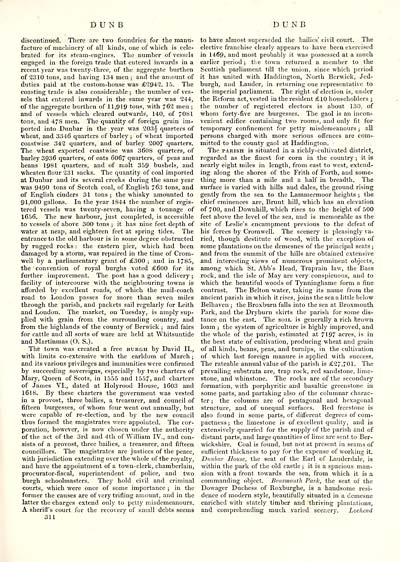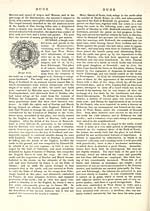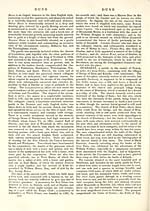Topographical dictionary of Scotland > Volume 1
(325) Page 311 - DUN
Download files
Complete book:
Individual page:
Thumbnail gallery: Grid view | List view

D U N B
D U N B
discontinued. There are two foundries for the manu-
facture of machinery of all kinds, one of which is cele-
brated for its steam-engines. The number of vessels
engaged in the foreign trade that entered inwards in a
recent year was twenty-three, of the aggregate burthen
of 2310 tons, and having 134 men; and the amount of
duties paid at the custom-house was £2942. 15. The
coasting trade is also considerable ; the number of ves-
sels that entered inwards in the same year was 244,
of the aggregate burthen of 11,919 tons, with 762 men ;
and of vessels which cleared outwards, 140, of 70S1
tons, and 478 men. The quantity of foreign grain im-
ported into Dunbar in the year was 203§ quarters of
wheat, and 3346 quarters of barley ; of wheat imported
coastwise 342 quarters, and of barley 2007 quarters.
The wheat exported coastwise was 3608 quarters, of
barley 3936 quarters, of oats 6067 quarters, of peas and
beans 1981 quarters, and of malt 359 bushels, and
wheaten flour 231 sacks. The quantity of coal imported
at Dunbar and its several creeks during the same year
was 9490 tons of Scotch coal, of English 763 tons, and
of English cinders 31 tons ; the whisky amounted to
91,000 gallons. In the year 1844 the number of regis-
tered vessels was twenty-seven, having a tonnage of
1656. The new harbour, just completed, is accessible
to vessels of above 300 tons ; it has nine feet depth of
water at neap, and eighteen feet at spring tides. The
entrance to the old harbour is in some degree obstructed
by rugged rocks : the eastern pier, which had been
damaged by a storm, was repaired in the time of Crom-
well by a parliamentary grant of £300 ; and in 1785,
the ' convention of royal burghs voted £600 for its
further improvement. The post has a good delivery ;
facility of intercourse with the neighbouring towns is
afforded by excellent roads, of which the mail-coach
road to London passes for more than seven miles
through the parish, and packets sail regularly for Leith
and London. The market, on Tuesday, is amply sup-
plied with grain from the surrounding country, and
from the highlands of the county of Berwick ; and fairs
for cattle and all sorts of ware are held at Whitsuntide
and Martinmas (O. S.).
The town was created a free burgh by David II.,
with limits co-extensive with the earldom of March ;
and its various privileges and immunities were confirmed
by succeeding sovereigns, especially by two charters of
Mary, Queen of Scots, in 1555 and 1557, and charters
of James VI., dated at Holyrood House, 1603 and
161S. By these charters the government was vested
in a provost, three bailies, a treasurer, and council of
fifteen burgesses, of whom four went out annually, but
were capable of re-election, and by the new council
thus formed the magistrates were appointed. The cor-
poration, however, is now chosen under the authority
of the act of the 3rd and 4th of William IV., and con-
sists of a provost, three bailies, a treasurer, and fifteen
councillors. The magistrates are justices of the peace,
with jurisdiction extending over the whole of the royalty,
and have the appointment of a town-clerk, chamberlain,
procurator-fiscal, superintendent of police, and two
burgh schoolmasters. They hold civil and criminal
courts, which were once of some importance ; in the
former the causes are of very trifling amount, and in the
latter the charges extend only to petty misdemeanours.
A sheriff's court for the recovery of small debts seems
311
to have almost superseded the bailies' civil court. The
elective franchise clearly appears to have been exercised
in 1469, and most probably it was possessed at a much
earlier period ; the town returned a member to the
Scottish parliament till the union, since which period
it has united with Haddington, North Berwick, Jed-
burgh, and Lauder, in returning one representative to
the imperial parliament. The right of election is, under
the Reform act, vested in the resident £10 householders ;
the number of registered electors is about 130, of
whom forty-five are burgesses. The gaol is an incon-
venient edifice containing two rooms, and only fit for
temporary confinement for petty misdemeanours ; all
persons charged with more serious offences are com-
mitted to the county gaol at Haddington.
The parish is situated in a richly-cultivated district,
regarded as the finest for corn in the country ; it is
nearly eight miles in length, from east to west, extend-
ing along the shores of the Frith of Forth, and some-
thing more than a mile and a half in breadth. The
surface is varied with hills and dales, the ground rising
gently from the sea to the Lammermoor heights ; the
chief eminences are, Brunt hill, which has an elevation
of 700, and Downhill, which rises to the height of 500
feet above the level of the sea, and is memorable as the
site of Leslie's encampment previous to the defeat of
his forces by Cromwell. The scenery is pleasingly va-
ried, though destitute of wood, with the exception of
some plantations on the demesnes of the principal seats;
and from the summit of the hills are obtained extensive
and interesting views of numerous prominent objects,
among which St. Abb's Head, Traprain law, the Bass
rock, and the isle of May are very conspicuous, and to
which the beautiful woods of Tynninghame form a fine
contrast. The Belton water, taking its name from the
ancient parish in which it rises, joins the sea a little below
Belhaven ; the Broxburn falls into the sea at Broxmouth
Park, and the Dryburn skirts the parish for some dis-
tance on the east. The soil is generally a rich brown
loam ; the system of agriculture is highly improved, and
the whole of the parish, estimated at 7197 acres, is in
the best state of cultivation, producing wheat and grain
of all kinds, beans, peas, and turnips, in the cultivation
of which last foreign manure is applied with success.
The rateable annual value of the parish is £27,701. The
prevailing substrata are, trap rock, red sandstone, lime-
stone, and whinstone. The rocks are of the secondary
formation, with porphyritic and basaltic greenstone in
some parts, and partaking also of the columnar charac-
ter ; the columns are of pentagonal and hexagonal
structure, and of unequal surfaces. Red freestone is
also found in some parts, of different degrees of com-
pactness; the limestone is of excellent quality, and is
extensively quarried for the supply of the parish and of
distant parts, and large quantities of lime are sent to Ber-
wickshire. Coal is found, but not at present in seams of
sufficient thickness to pay for the expense of working it.
Dunbar House, the seat of the Earl of Lauderdale, is
within the park of the old castle ; it is a spacious man-
sion with a front towards the sea, from which it is a
commanding object. Broxmouth Park, the seat of the
Dowager Duchess of Roxburghe, is a handsome resi-
dence of modern style, beautifully situated in a demesne
enriched with stately timber and thriving plantations,
and comprehending much varied scenery. Lochend
D U N B
discontinued. There are two foundries for the manu-
facture of machinery of all kinds, one of which is cele-
brated for its steam-engines. The number of vessels
engaged in the foreign trade that entered inwards in a
recent year was twenty-three, of the aggregate burthen
of 2310 tons, and having 134 men; and the amount of
duties paid at the custom-house was £2942. 15. The
coasting trade is also considerable ; the number of ves-
sels that entered inwards in the same year was 244,
of the aggregate burthen of 11,919 tons, with 762 men ;
and of vessels which cleared outwards, 140, of 70S1
tons, and 478 men. The quantity of foreign grain im-
ported into Dunbar in the year was 203§ quarters of
wheat, and 3346 quarters of barley ; of wheat imported
coastwise 342 quarters, and of barley 2007 quarters.
The wheat exported coastwise was 3608 quarters, of
barley 3936 quarters, of oats 6067 quarters, of peas and
beans 1981 quarters, and of malt 359 bushels, and
wheaten flour 231 sacks. The quantity of coal imported
at Dunbar and its several creeks during the same year
was 9490 tons of Scotch coal, of English 763 tons, and
of English cinders 31 tons ; the whisky amounted to
91,000 gallons. In the year 1844 the number of regis-
tered vessels was twenty-seven, having a tonnage of
1656. The new harbour, just completed, is accessible
to vessels of above 300 tons ; it has nine feet depth of
water at neap, and eighteen feet at spring tides. The
entrance to the old harbour is in some degree obstructed
by rugged rocks : the eastern pier, which had been
damaged by a storm, was repaired in the time of Crom-
well by a parliamentary grant of £300 ; and in 1785,
the ' convention of royal burghs voted £600 for its
further improvement. The post has a good delivery ;
facility of intercourse with the neighbouring towns is
afforded by excellent roads, of which the mail-coach
road to London passes for more than seven miles
through the parish, and packets sail regularly for Leith
and London. The market, on Tuesday, is amply sup-
plied with grain from the surrounding country, and
from the highlands of the county of Berwick ; and fairs
for cattle and all sorts of ware are held at Whitsuntide
and Martinmas (O. S.).
The town was created a free burgh by David II.,
with limits co-extensive with the earldom of March ;
and its various privileges and immunities were confirmed
by succeeding sovereigns, especially by two charters of
Mary, Queen of Scots, in 1555 and 1557, and charters
of James VI., dated at Holyrood House, 1603 and
161S. By these charters the government was vested
in a provost, three bailies, a treasurer, and council of
fifteen burgesses, of whom four went out annually, but
were capable of re-election, and by the new council
thus formed the magistrates were appointed. The cor-
poration, however, is now chosen under the authority
of the act of the 3rd and 4th of William IV., and con-
sists of a provost, three bailies, a treasurer, and fifteen
councillors. The magistrates are justices of the peace,
with jurisdiction extending over the whole of the royalty,
and have the appointment of a town-clerk, chamberlain,
procurator-fiscal, superintendent of police, and two
burgh schoolmasters. They hold civil and criminal
courts, which were once of some importance ; in the
former the causes are of very trifling amount, and in the
latter the charges extend only to petty misdemeanours.
A sheriff's court for the recovery of small debts seems
311
to have almost superseded the bailies' civil court. The
elective franchise clearly appears to have been exercised
in 1469, and most probably it was possessed at a much
earlier period ; the town returned a member to the
Scottish parliament till the union, since which period
it has united with Haddington, North Berwick, Jed-
burgh, and Lauder, in returning one representative to
the imperial parliament. The right of election is, under
the Reform act, vested in the resident £10 householders ;
the number of registered electors is about 130, of
whom forty-five are burgesses. The gaol is an incon-
venient edifice containing two rooms, and only fit for
temporary confinement for petty misdemeanours ; all
persons charged with more serious offences are com-
mitted to the county gaol at Haddington.
The parish is situated in a richly-cultivated district,
regarded as the finest for corn in the country ; it is
nearly eight miles in length, from east to west, extend-
ing along the shores of the Frith of Forth, and some-
thing more than a mile and a half in breadth. The
surface is varied with hills and dales, the ground rising
gently from the sea to the Lammermoor heights ; the
chief eminences are, Brunt hill, which has an elevation
of 700, and Downhill, which rises to the height of 500
feet above the level of the sea, and is memorable as the
site of Leslie's encampment previous to the defeat of
his forces by Cromwell. The scenery is pleasingly va-
ried, though destitute of wood, with the exception of
some plantations on the demesnes of the principal seats;
and from the summit of the hills are obtained extensive
and interesting views of numerous prominent objects,
among which St. Abb's Head, Traprain law, the Bass
rock, and the isle of May are very conspicuous, and to
which the beautiful woods of Tynninghame form a fine
contrast. The Belton water, taking its name from the
ancient parish in which it rises, joins the sea a little below
Belhaven ; the Broxburn falls into the sea at Broxmouth
Park, and the Dryburn skirts the parish for some dis-
tance on the east. The soil is generally a rich brown
loam ; the system of agriculture is highly improved, and
the whole of the parish, estimated at 7197 acres, is in
the best state of cultivation, producing wheat and grain
of all kinds, beans, peas, and turnips, in the cultivation
of which last foreign manure is applied with success.
The rateable annual value of the parish is £27,701. The
prevailing substrata are, trap rock, red sandstone, lime-
stone, and whinstone. The rocks are of the secondary
formation, with porphyritic and basaltic greenstone in
some parts, and partaking also of the columnar charac-
ter ; the columns are of pentagonal and hexagonal
structure, and of unequal surfaces. Red freestone is
also found in some parts, of different degrees of com-
pactness; the limestone is of excellent quality, and is
extensively quarried for the supply of the parish and of
distant parts, and large quantities of lime are sent to Ber-
wickshire. Coal is found, but not at present in seams of
sufficient thickness to pay for the expense of working it.
Dunbar House, the seat of the Earl of Lauderdale, is
within the park of the old castle ; it is a spacious man-
sion with a front towards the sea, from which it is a
commanding object. Broxmouth Park, the seat of the
Dowager Duchess of Roxburghe, is a handsome resi-
dence of modern style, beautifully situated in a demesne
enriched with stately timber and thriving plantations,
and comprehending much varied scenery. Lochend
Set display mode to: Large image | Transcription
Images and transcriptions on this page, including medium image downloads, may be used under the Creative Commons Attribution 4.0 International Licence unless otherwise stated. ![]()
| Gazetteers of Scotland, 1803-1901 > Topographical dictionary of Scotland > Volume 1 > (325) Page 311 - DUN |
|---|
| Permanent URL | https://digital.nls.uk/97485934 |
|---|
| Description | Volume I: From Abbey to Jura. |
|---|---|
| Attribution and copyright: |
|

